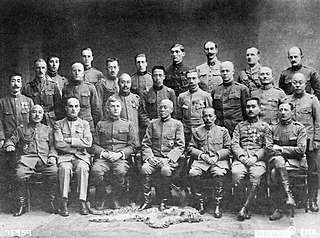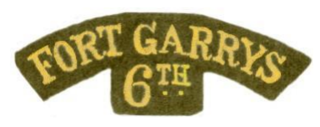
The 12e Régiment blindé du Canada is a Canadian Army armoured regiment based in CFB Valcartier, on the outskirts of Quebec City. The regiment has both a Regular Force and a Primary Reserve unit. The 12e Régiment blindé du Canada's abbreviation is 12e RBC.
The Canadian Expeditionary Force (CEF) was the expeditionary field force of Canada during the First World War. It was formed following Britain’s declaration of war on the German Empire on 15 August 1914, with an initial strength of one infantry division. The division subsequently fought at Ypres on the Western Front, with a newly raised second division reinforcing the committed units to form the Canadian Corps. The CEF and corps was eventually expanded to four infantry divisions, which were all committed to the fighting in France and Belgium along the Western Front. A fifth division was partially raised in 1917, but was broken up in 1918 and used as reinforcements following heavy casualties.

The Allied intervention in the Russian Civil War consisted of a series of multi-national military expeditions that began in 1918. The initial impetus behind the interventions was to secure munitions and supply depots from falling into the German Empire's hands, particularly after the Bolsheviks signed the Treaty of Brest-Litovsk, and to rescue the Allied forces that had become trapped within Russia after the 1917 October Revolution. After the Armistice of 11 November 1918, the Allied plan changed to helping the White forces in the Russian Civil War. After the Whites collapsed, the Allies withdrew their forces from Russia by 1925.
The 125th Battalion, CEF was a unit in the Canadian Expeditionary Force during the First World War.

The Siberian intervention or Siberian expedition of 1918–1922 was the dispatch of troops of the Entente powers to the Russian Maritime Provinces as part of a larger effort by the western powers, Japan, and China to support White Russian forces and the Czechoslovak Legion against Soviet Russia and its allies during the Russian Civil War. The Imperial Japanese Army continued to occupy Siberia even after other Allied forces withdrew in 1920.

The 5th Battalion Canadian Mounted Rifles were a mounted infantry unit of the Canadian Expeditionary Force (CEF) during World War I. The unit was raised from volunteers of the 7th and XIth (Canadian) Hussars from the Eastern Townships of Quebec.

The 2nd Battalion, Canadian Expeditionary Force was an infantry battalion of the Canadian Army created in response to outbreak of the First World War in August 1914. The battalion comprised local militia in many regions of Ontario. Men came from as far away as Sault Ste. Marie to join in Canada's military endeavour. Local militia gathered at Valcartier, in August 1914 and became part of the 2nd Battalion.

The Canadian Siberian Expeditionary Force (French: Corps expéditionnaire sibérien) (also referred to as the Canadian Expeditionary Force (Siberia) or simply the C.S.E.F.) was a Canadian military force sent to Vladivostok, Russia, during the Russian Revolution to bolster the allied presence, oppose the Bolshevik Revolution and attempt to keep Russia in the fight against Germany. Composed of 4,192 soldiers and authorized in August 1918, the force returned to Canada between April and June 1919. The force was commanded by Major General James H. Elmsley. During this time, the C.S.E.F. saw little fighting, with fewer than 100 troops proceeding "up country" to Omsk, to serve as administrative staff for 1,500 British troops aiding the anti-Bolshevik White Russian government of Admiral Alexander Kolchak. Most Canadians remained in Vladivostok, undertaking routine drill and policing duties in the volatile port city.

The 22nd Battalion, CEF, was an infantry battalion of the Canadian Expeditionary Force in the Great War.

The Victoria Rifles of Canada was an infantry regiment of the Non-Permanent Active Militia of the Canadian Militia and later the Canadian Army. First formed in Montreal, Quebec in 1862, the regiment would see a history of service stretching from the Fenian Raids of the 1860s-70s right into the middle of the 20th Century. In 1965, the regiment was reduced to nil strength and transferred to the Supplementary Order of Battle.

Paul Fleetford Sise was a Canadian businessman, President of Northern Electric, graduated from McGill University in 1901 and was an adjutant to the 148th Battalion, CEF, from Montreal. Major Sise also served in the 259th Battalion, Canadian Rifles, CEF (Siberia) as part of the Canadian Siberian Expeditionary Force, where he was one of the three panel members for the court martial of nine soldiers charged with mutiny

4th Battalion, CEF was an infantry battalion raised as part of the Canadian Expeditionary Force for service during the First World War. Raised in Canada in September 1914, the battalion sailed to the United Kingdom within weeks of its establishment. After a short period of training it was committed to the fighting on the Western Front, remaining in France and Belgium until the war ended. It returned to Canada in mid-1919 and after its personnel had been demobilized, the battalion was subsequently disbanded in 1920.

The 2nd Canadian Mounted Rifles Battalion, was authorized on 7 November 1914 as the 2nd Regiment, Canadian Mounted Rifles, CEF. The battalion recruited in Victoria and Vernon, British Columbia and was mobilized in Victoria. An earlier incarnation was raised for Boer War.

The 6th Battalion, CEF was a battalion of the Canadian Expeditionary Force during the First World War.

The 4th Battalion, Canadian Mounted Rifles was authorized on 7 November 1914 as the 4th Regiment, Canadian Mounted Rifles, CEF and embarked for Britain on 18 July 1915. It disembarked in France on 24 October 1915, where it fought as part of the 2nd Brigade Canadian Mounted Rifles until 31 December 1915, when it was converted to infantry and allocated to the 8th Canadian Infantry Brigade, 3rd Canadian Division. The regiment was redesignated the 4th Battalion, Canadian Mounted Rifles, CEF on 1 January 1916 and was disbanded on 6 November 1920.

The 24th Battalion, CEF, was an infantry battalion of the Canadian Expeditionary Force during World War I.

The 8th Battalion, CEF, also known by the nickname of The Little Black Devils of Canada, was an infantry battalion of the Canadian Expeditionary Force during the Great War. The battalion was authorized on 10 August 1914 and embarked for Great Britain on 1 October 1914. It disembarked in France on 13 February 1915, where it fought as part of the 2nd Canadian Brigade, 1st Canadian Division in France and Flanders until the end of the war. The battalion was disbanded on 15 September 1920.

The 46th Battalion, CEF, was an infantry battalion of the Canadian Expeditionary Force during the Great War.

The 60th Battalion, CEF was an infantry battalion of the Canadian Expeditionary Force during the Great War.
The 15th Battalion, CEF was an infantry battalion of the Canadian Expeditionary Force during the Great War. The 15th Battalion was authorized on 1 September 1914, embarked for Britain on 26 September 1914 and arrived in France on 15 February 1915. The battalion fought as part of the 3rd Canadian Brigade, 1st Canadian Division in France and Flanders throughout the war. The battalion was disbanded on 30 August 1920.

















